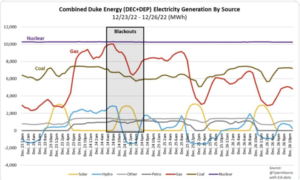American Clean Power says Colorado has nearly 6,300 MW of wind, solar, and storage capacity that can power 2.3 million homes at a cost of $12 billion. So why don’t they? Because they can’t. The power they provide is intermittent and unreliable. Sometimes they can’t provide power at all.
The bitter cold and rolling blackouts Colorado experienced over Christmas should be a wake up call for the political class to clean up its energy policy, dump the unachievable 100 percent renewable goal, and go nuclear.
Reliable and clean
When the temperature plummeted well below zero in Colorado, so did power output from wind. Xcel Energy and other utilities relied on coal and natural gas to keep Coloradans and their holiday visitors from freezing. Still some residents lost power. At our house in Greeley, power was out for over two hours in the wee hours of Christmas morning.
For a state that fancies itself a leader in clean energy, ignoring popular, reliable, and clean nuclear energy is perplexing.
According to the fall 2022 American Climate Perspectives Survey, roughly 70 percent of respondents support nuclear power “because it reliably generates a lot of electricity … while reducing pollution to our climate.” They’re right. At 92.5 percent, nuclear has by far the highest capacity factor of any energy source. It makes sense that nuclear is enjoying a renaissance across all demographic groups – except Colorado’s political class.
In my adopted state of North Carolina, where overnight wind chills plunged below zero during the holidays, solar provided no power. To be fair, solar did contribute minimally during the short daylight hours, but nuclear was the workhorse (see Figure 1). Clean, reliable nuclear has provided the state nearly 30 percent of its electricity for decades.

While coal and natural gas production declined due to equipment failures, their contribution was higher and more reliable than solar. Still, higher than anticipated demand left roughly 450,000 residents without power at some point during the brutal cold spell. Some because high winds knocked out power lines, others because of rolling blackouts.
No state should tolerate the “new normaling of blackouts.” Capacity shortfalls once unique to California are rolling from west to east “faster than even Imperial College London modelers would find believable,” in the words of my John Locke Foundation colleague Jon Sanders. Telling people to use less power, put on a sweater, or throw another log on the fire aren’t long-term solutions to bad climate policies that have forced the misallocation of ratepayer dollars to energy sources that don’t produce power when needed.
Consider this confession from a North Carolina solar power application, “Solar is an intermittent energy source, and therefore the maximum dependable capacity is 0 MW.” When people need energy the most, solar’s contribution may be zero. The same is true for wind. Investment in unreliable sources and throttling investment in reliable sources will result in more blackouts, especially as the political class embraces green building codes and electric vehicle mandates that increase electricity demand.
Colorado does pay lip service to nuclear. In 2018 the legislature passed a law requiring the Colorado Energy Office (CEO) to promote nuclear as a “cleaner” energy source, but the head of the agency, Will Toor, has ignored that instruction. A search for a mention of nuclear on the agency’s website yields no results.
A model for Colorado
North Carolina’s bipartisan legislation H.B. 951 “Energy Solutions for North Carolina” could be a model for Colorado. The policy goal is 70 percent CO2 reduction from 2005 levels by 2030 and carbon neutrality by 2050, but the legislature doesn’t mandate the generation mix to do it. Instead, it provides guardrails to protect the grid and ratepayers, encourages innovative technology, and includes some flexibility on the timeline. For instance, any new “generation and resource changes must maintain or improve upon the adequacy and reliability of the existing grid” and it must be the least cost for compliance.
The John Locke Foundation’s influential study, titled Energy Crossroads: Exploring North Carolina’s Two Energy Futures, provided the intellectual foundation for H.B. 951. We didn’t debate the zero-carbon dioxide emissions policy goal. Rather, we compared alternatives to achieving the goal and then provided the least-cost, most reliable method to do so. Spoiler alert: The answer is nuclear energy. When factoring in the need for significantly greater capacity, backup generation, transmission, and failure rate, our paper shows renewables are prohibitively expensive.
There was a similar finding in a 2019 Independence Institute paper, The Radical Reorganization of Colorado’s Electric Grid: The Cost of Keeping the Lights On. Modeling showed even greater costs to Colorado ratepayers – $941 billion plus – to reach 100 percent renewable energy by 2040. Nuclear is the solution.
H.B. 951 also allows for improved carbon capture technology for natural gas and coal, avoiding the need for premature retirement of baseload coal.
H.B. 951 is landmark legislation. It prioritizes ratepayers, economic health, and environmental stewardship over special interests. It could be a model for Colorado, but only if the political class is willing to clean up its energy policy and go nuclear. Otherwise, Coloradans should prepare for something worse than the Christmas 2022 cold spell.
Amy Cooke is the CEO of the John Locke Foundation, a state-based free market think tank in North Carolina. Prior to joining Locke, Ms. Cooke served as the executive vice president and the director of energy policy for the Independence Institute in Colorado.


